Early Europe - Iron Age - Sold antiquities
Archive of sold antiquities
All artefacts sold in our gallery are fully documented in our online archive and database. Being a specialist ancient art dealer, preserving also the more recent history of each and every piece sold in our shop is at our heart. That is particularly useful for artefacts that changed owners in the meantime. Information that may have been lost in the process can be easily restored from our archives. Please do not hesitate to contact us if you need further information about ancient items that have been sold in our gallery. We can help you with reconstructing the history of ownership for those items. All information about our customers will be kept confidential, of course.-
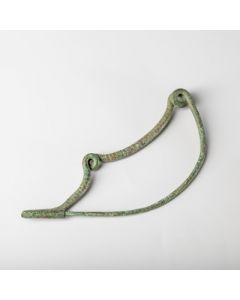 Large Villanovan fibula with incised decoration
Large Villanovan fibula with incised decorationImposing bronze brooch of the Italic Iron Age. Beautiful incised decoration.
Price: on request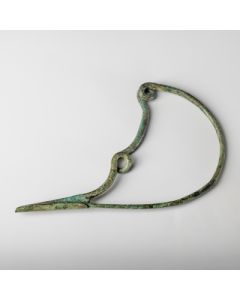 Large Villanovan fibula
Large Villanovan fibulaImposing bronze brooch of the italic Iron Age. Acquired 1986 at Casa Serodine.
Price: on request Italic quatrefoil fibula
Italic quatrefoil fibulaExtremely well preserved double spectacle brooch dating to the early Iron Age in Italy. 8th cent. BC. Acquired 1989 at Casa Serodine.
Price: on request Iron spear head worth the exhibition in a museum
Iron spear head worth the exhibition in a museumVery nice patina, smooth surface, rare degree of preservation for an iron object.
Price: on request Group of Italic brooches and artefacts
Group of Italic brooches and artefactsExciting group of 17 bronze objects. These include an Italian serpentine fibula with large disc head, three early Etruscan brooches, and a bronze sheet with a decorative head.
Price: on request Early Etruscan fibula
Early Etruscan fibulaThe early Etruscan bronze brooch is characterized by its artistically decorated bow. A find from northern Italy.
Price: on request Early Etruscan sanguisuga fibula
Early Etruscan sanguisuga fibulaThe early Etruscan bronze brooch is characterized by its artistically decorated bow. From the collection of Professor Alder-Kissling.
Price: on request Magnificent neck ring from Greece
Magnificent neck ring from GreeceThe solid bronze ring is beautifully decorated with spiral grooves and punched decoration. An impressive piece from the Iron Age. With expertise from 1987.
Price: on request Iron Age spearhead from Sweden
Iron Age spearhead from SwedenWell-preserved iron weapon, a find from the Swedish province of Värmland. Acquired in 1894 into the collection of the Bally-Prior Museum.
Price: on request Phrygian fibula from the Hattatt collection
Phrygian fibula from the Hattatt collectionBronze fibula from Anatolia around the time of King Midas. The piece is published in two standard works and was on loan to the Ashmolean Museum.
Price: on request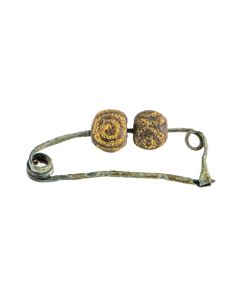 Early Italic brooch decorated with beads
Early Italic brooch decorated with beadsThere rare brooch type from northern Italy is based on predecessors from Greece. The piece is from the famous Richard Hattatt collection and is published in two of his works.
Price: on request Large Villanovan fibula from the Hattatt collection
Large Villanovan fibula from the Hattatt collectionImposing bronze brooch of the Italic Iron Age. The piece is published in the standard work "Brooches of Antiquity".
Price: on request Italic fibula with nice incised decoration
Italic fibula with nice incised decorationLarge bronze brooch of a typical boat-shape from Iron Age Italy. A special feature and rarity are the three links of a chain still hanging on the pin.
Price: on request Villanovan fibula from the Hattatt collection
Villanovan fibula from the Hattatt collectionSerpentine bronze brooch of the Italic Iron Age. The piece is published in the standard work "Brooches of Antiquity".
Price: on request Villanovan fibula from the Hattatt collection
Villanovan fibula from the Hattatt collectionBronze brooch of the Italic Iron Age. The piece is published in the standard work "Brooches of Antiquity".
Price: on request Daunian jug with high handle
Daunian jug with high handleItalic pottery in the subgeometric style. Made around 500 BC in Apulia. Handled vessels of this type are an guiding form in Apulian archaeology.
Price: on request Daunian bird askos
Daunian bird askosItalic pottery in the subgeometric style. Made around 500 BC in Apulia. An attractive vessel due to the beautiful painting and the bird shape.
Price: on request Scythian short sword
Scythian short swordThe so-called acinaces is a typical weapon of the Scythians. Well preserved piece from the 7th to 5th centuries BC.
Price: on request Early Villanovan Amphoriskos
Early Villanovan AmphoriskosImpressive impasto vessel with nice decorations. Including TL analysis report.
Price: on request Italic chestplate with fine decorations
Italic chestplate with fine decorationsBronze armour from the fascinating transitional period between the late Villanova culture and the early Etruscans. Decorated with bands of zigzag and swastica.
Price: on request Early fibula from Magna Graecia
Early fibula from Magna GraeciaGreek silver brooch and piece of jewellery from the South Italian colonies. Geometric period.
Price: on request Large decorated violin bow fibula
Large decorated violin bow fibulaImpressive piece of jewellery because of its size and decoration. From Central Europe, made during Late Bronze Age or Early Iron Age.
Price: on request Socketed axe head from Southern Germany
Socketed axe head from Southern GermanyA typical bronze tool of the late Urnfield culture or early Hallstatt culture. It was found near Regensburg in Southern Germany by a voluntary archaeologist.
Price: on request Vessel of the Urnfield culture
Vessel of the Urnfield cultureNicely preserved pottery dating to the Urnfield period, the transition between Bronze Age and Iron Age in Central Europe. Found in Southern Germany. 1200 to 800 BC.
Price: on request Melon bracelet from the Hallstatt period
Melon bracelet from the Hallstatt periodThe massive bronze bracelet was found in Mintraching, Germany. The piece is published in an archeological report. Around 600 BC.
Price: on request Italic Quatrefoil Fibula
Italic Quatrefoil FibulaExtremely well preserved double spectacle brooch dating to the early Iron Age in Italy. 8th cent. BC.
Price: on request Large Villanova culture krater
Large Villanova culture kraterVery large, impressively preserved object. From an old Dutch private collection.
Price: on request Large published Cypriot amphora
Large published Cypriot amphoraVery large, impressively preserved object. From an old German private collection, acquired at London art gallery or auction around 1970. Coming with an ArtLoss certificate.
Price: on request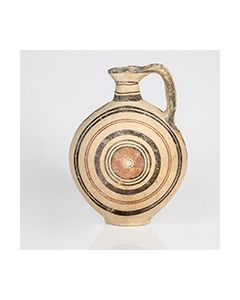 Large published Cypriot oinochoe
Large published Cypriot oinochoeDating to the early cypro-archaic period, so-called bichrome ware IV. From an old German private collection, acquired at Sotheby's in 1970. Coming with an ArtLoss certificate.
Price: on request Very large cypriot bowl
Very large cypriot bowlDating to the early cypro-archaic period, so-called black-on-red ware II. From an old German private collection. Coming with an ArtLoss certificate.
Price: on request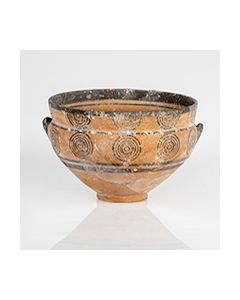 Large cypriot bowl, ex Sotheby's
Large cypriot bowl, ex Sotheby'sDating to the early cypro-archaic period, so-called black-on-red ware II. From an old German private collection, acquired 1970 at Sotheby's. Coming with an ArtLoss certificate.
Price: on request Published cypriot kylix, ex Christie's
Published cypriot kylix, ex Christie'sExcellently preserved. 1977 on exhibition in the Bielefeld Museum of Fine Arts. From an old German private collection, acquired 1972 at Christie's. Coming with an ArtLoss certificate.
Price: on request Large published cypriot krater, ex Sotheby's
Large published cypriot krater, ex Sotheby'sFully preserved piece, very rare for an object of this size. 1977 on exhibition in the Bielefeld Museum of Fine Arts. From an old German private collection, acquired 1971 at Sotheby's. Coming with an ArtLoss certificate.
Price: on request Etruscan bucchero urn with lid - found in Cerveteri
Etruscan bucchero urn with lid - found in CerveteriEarly 6th century BC. Perfectly preserved, from an old Swiss collection before 1930.
Price: on request Cup of the Urnfield culture
Cup of the Urnfield cultureCeramic vessel dating to the transition period between Bronze Age and Iron Age in Central Europe. 1200 to 800 BC. Found in an urnfield in Austria.
Price: on request Big Cup of the Urnfield culture
Big Cup of the Urnfield cultureCeramic vessel dating to the transition period between Bronze Age and Iron Age in Central Europe. 1200 to 800 BC. Found in an urnfield in Austria.
Price: on request

